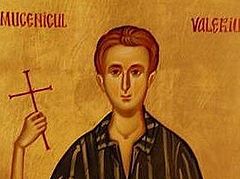Fr. Ilarion Felea was among the sixteen twentieth-century saints canonized by the Holy Synod of the Romanian Orthodox Church at its July session. He was canonized as a hieromartyr, to be commemorated on September 18 (new style). Here is the story of what happened in the communist prison when he died.
***
It was in 1960–1961 in the solitary confinement cells of Aiud. One day, news spread throughout all the prison dungeons via Morse code, tapped out on walls and radiators: “Fr. Ilarion Felea has died.” Who in Aiud didn’t know Fr. Ilarion? We all spread it down the line that he had been a professor at the Arad Orthodox Theological Academy, and for me he was a teacher and, most importantly, a mentor. We all knew him—residents of Bihor and Arad, Sibiu and Bucharest, and especially the Romanian Academy, which had awarded prizes for his books. He was an excellent preacher, speaking both in the Arad cathedral and wherever the Church called him. We, the faithful and students attending the cathedral, were always ready to repeat the homily we’d just heard from him.
His podium in the Theological Academy turned into an ambo; his beautiful baritone voice captivated everyone. Twenty pens would diligently write down his entire lecture in notebooks. Physically, he was an imposing figure—his face, framed by a beard, resembled a noble image minted on a coin. He was generous and sociable, and everyone loved him.
He was a Moț1 by origin, from the Crișul Alb Valley, which may have determined the high fate that befell him. He was sometimes invited to various events and celebrations:
“Father, sing us some songs about Iancu!”
And he would sing slowly and tenderly, transporting you to the world of Iancu and Horea, to the times of valor of the Moți...
When someone dies in body, those dear to them come and see them off on their final journey according to full Christian custom. But Fr. Ilarion was seen off—in spirit—by us, his brothers in ideals and sufferings. He wasn’t old yet—he died because he wasn’t given medical help; such was the practice in communist prisons.
We, the prisoners, monitored the patient’s condition until he closed his eyes forever. Upon learning of his passing to God, we kept prayerful vigil for two evenings until he was taken to the pit at Three Poplars, where the cemetery for political prisoners was located. On the second evening, those in the cells below, near the morgue, raised the alarm:
“They’re taking Fr. Ilarion to the pit now!”
And indeed, a cart could be heard—a Brașov carriage drawn by one horse, with two guards on the box, was carrying the coffin. There were three gates before the main gate, and in the silence of the night, the cart could be heard moving along.
We lay under our blankets, as it was already 10 o’clock, lights out, and we weren’t allowed to move. And then the funeral service began. All 5,000 political prisoners of Aiud, assisted by 400 Orthodox priests, prayed according to the rite: “With the saints give rest, O Christ, to the soul of Thy servant, Priest Ilarion, where there is neither pain, nor sorrow, nor sighing, but life everlasting.” Everyone recited these words, even if they had no priest in their cell; and if they did, a more extensive service was celebrated, also under the blankets.
Those sitting below reported to us that they had now reached the main gate, where the most horrific scene took place: The officer on duty came with a sharp iron bar and plunged it into the dead man’s heart to “ensure the authorities of the man’s death.” What a sinister and grim scene, worthy of the Middle Ages, yet it was being played out in our time, in the communist era.
The funeral cart approached Three Poplars, a wooden stake was driven into the ground at the head of the grave, and a tin plate with the prisoner’s number was nailed to it. According to communist laws, that’s all that remained of this human life.
When the funeral service concluded with the word “Amen,” Morse code tapped on the walls and radiator again: "May God grant him rest in the Heavenly Kingdom. Memory eternal!”





